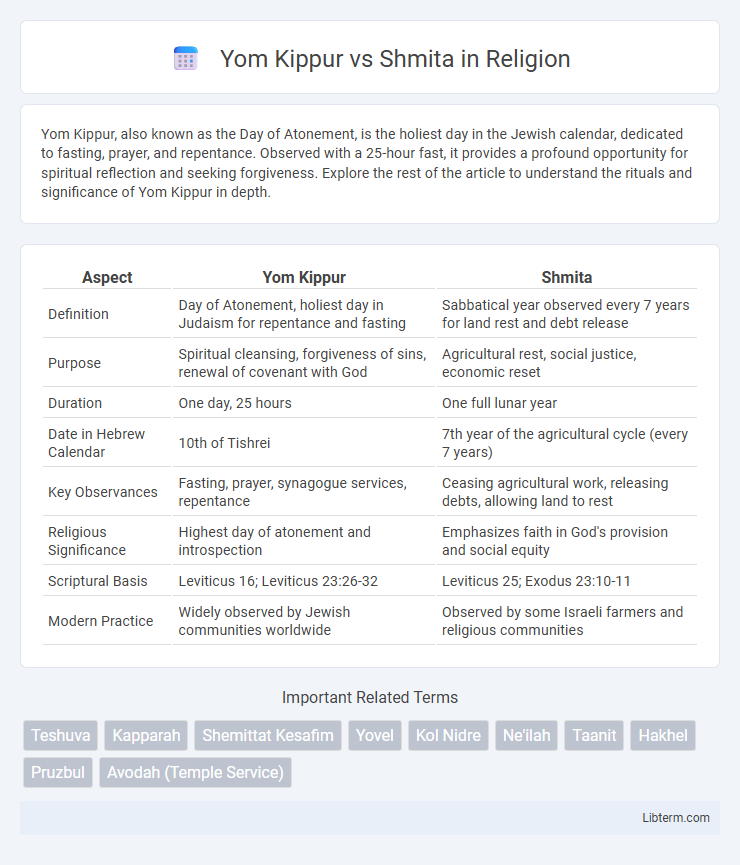Yom Kippur, also known as the Day of Atonement, is the holiest day in the Jewish calendar, dedicated to fasting, prayer, and repentance. Observed with a 25-hour fast, it provides a profound opportunity for spiritual reflection and seeking forgiveness. Explore the rest of the article to understand the rituals and significance of Yom Kippur in depth.
Table of Comparison
| Aspect | Yom Kippur | Shmita |
|---|---|---|
| Definition | Day of Atonement, holiest day in Judaism for repentance and fasting | Sabbatical year observed every 7 years for land rest and debt release |
| Purpose | Spiritual cleansing, forgiveness of sins, renewal of covenant with God | Agricultural rest, social justice, economic reset |
| Duration | One day, 25 hours | One full lunar year |
| Date in Hebrew Calendar | 10th of Tishrei | 7th year of the agricultural cycle (every 7 years) |
| Key Observances | Fasting, prayer, synagogue services, repentance | Ceasing agricultural work, releasing debts, allowing land to rest |
| Religious Significance | Highest day of atonement and introspection | Emphasizes faith in God's provision and social equity |
| Scriptural Basis | Leviticus 16; Leviticus 23:26-32 | Leviticus 25; Exodus 23:10-11 |
| Modern Practice | Widely observed by Jewish communities worldwide | Observed by some Israeli farmers and religious communities |
Introduction to Yom Kippur and Shmita
Yom Kippur, known as the Day of Atonement, is the holiest day in the Jewish calendar dedicated to fasting, prayer, and repentance. Shmita, or the Sabbatical Year, occurs every seven years and mandates the land of Israel to rest, prohibiting agricultural work to allow soil rejuvenation. Both practices emphasize spiritual renewal and obedience to divine commandments, reflecting core values in Judaism.
Historical Origins of Yom Kippur and Shmita
Yom Kippur, known as the Day of Atonement, originates from biblical commands in Leviticus 16, where ancient Israelites observed a high priestly ritual to atone for communal sins. Shmita, or the Sabbatical Year, is rooted in Exodus 23:10-11 and Leviticus 25, mandating agricultural rest every seven years to allow the land to lie fallow and debts to be forgiven. Both practices reflect foundational Israelite religious law emphasizing cycles of purification and renewal intrinsic to Judaic tradition.
Core Spiritual Significance
Yom Kippur emphasizes atonement, forgiveness, and spiritual renewal through fasting and prayer, underscoring repentance and divine judgment. Shmita, occurring every seven years, highlights ecological rest and trust in divine providence, promoting social justice and sustainable agriculture. Both practices center on profound spiritual restoration, balancing personal introspection with communal responsibility.
Ritual Practices and Observances
Yom Kippur involves extensive ritual practices such as fasting for approximately 25 hours, intensive prayer services, and wearing white garments symbolizing purity. Shmita, observed every seventh year, incorporates agricultural rest rituals including the prohibition of planting, harvesting, and commercial agricultural activity in the Land of Israel. While Yom Kippur's observance centers on individual and communal atonement rituals within a single day, Shmita mandates a year-long socioeconomic reset focusing on land rest, debt release, and social justice.
Differences in Timing and Frequency
Yom Kippur occurs annually on the 10th day of Tishrei, marking a fixed date in the Hebrew calendar for atonement and fasting. In contrast, Shmita is observed every seventh year in the agricultural cycle, emphasizing land rest and debt release throughout the entire year. The annual timing of Yom Kippur contrasts with the cyclical, once-in-seven-years observance of Shmita.
Impact on Jewish Community Life
Yom Kippur, the Day of Atonement, profoundly influences Jewish community life by fostering collective repentance, spiritual renewal, and strict fasting that unites individuals in shared solemnity and reflection. Shmita, the Sabbatical year observed every seventh year, impacts community dynamics through agricultural rest, debt release, and social equity, emphasizing sustainable living and economic reset that strengthens communal bonds. Both observances reinforce Jewish values by promoting introspection, ethical behavior, and social responsibility within the community.
The Role of Repentance and Forgiveness
Yom Kippur emphasizes personal repentance and divine forgiveness through fasting, prayer, and introspection, marking the holiest day in the Jewish calendar dedicated to atonement. Shmita, occurring every seventh year, extends the concept of forgiveness to the land and society by mandating rest for agricultural fields and debt release, promoting economic and social reset within the community. Both observances highlight themes of renewal and mercy but operate on different temporal and communal scales.
Agricultural and Societal Implications
Yom Kippur, known as the Day of Atonement, primarily involves personal and communal fasting, spiritual reflection, and repentance, impacting societal cohesion through collective introspection and renewal. Shmita, the Sabbatical Year observed every seven years in Jewish law, mandates the cessation of agricultural activity, allowing the land to lie fallow and redistributing resources to the poor, thereby promoting ecological sustainability and social equity. While Yom Kippur fosters immediate spiritual purification, Shmita enforces long-term agricultural rest and systemic economic balance within the community.
Scriptural Sources and Interpretations
Yom Kippur, described in Leviticus 16 and 23:26-32, is the Day of Atonement dedicated to repentance, fasting, and prayer, while Shmita, outlined in Leviticus 25:1-7, mandates a sabbatical year wherein the land rests and debts are forgiven. Rabbinic interpretations in the Talmud emphasize Yom Kippur's role in personal and communal purification, contrasting with Shmita's focus on agricultural rest and social justice. Both observances highlight cycles of renewal, with Yom Kippur addressing spiritual atonement and Shmita promoting ecological and economic balance.
Contemporary Relevance and Modern Application
Yom Kippur, the Day of Atonement, emphasizes spiritual reflection and repentance, fostering personal and communal renewal, while Shmita, the sabbatical year, mandates agricultural rest and debt forgiveness, highlighting sustainable living and social equity. In contemporary society, Yom Kippur inspires mindfulness practices and ethical accountability across diverse communities, whereas Shmita informs modern movements advocating for environmental preservation and economic justice. Both observances remain relevant by addressing individual morality and collective responsibility in today's complex social and ecological systems.
Yom Kippur Infographic

 libterm.com
libterm.com